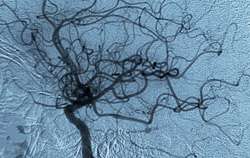Novel target for existing drug may improve success of radiation therapy

(PhysOrg.com) -- Scientists at Washington University School of Medicine in St. Louis have discovered a new drug target that could improve the effectiveness of radiation for hard-to-treat cancers.
The finding, published in the Journal of the National Cancer Institute, focuses on the role of the enzyme cytosolic phospholipase A2 (cPLA2). This enzyme promotes development and functioning of blood vessel networks that feed malignant tumors, enabling them to overcome the effects of radiation.
They have also identified a drug that stops production of the enzyme. Inhibiting the enzyme can stop the flow of blood tumors need to survive.
Cancers thrive and spread thanks to a unique ability to recruit networks of new blood vessels that penetrate into tumors, bringing oxygen and nutrients and potentially transporting cancer cells to other parts of the body.
Cancer cells start the process of new blood vessel construction, called angiogenesis, by releasing specific molecules into surrounding normal tissue, kicking off a cascade of molecular signals that cause cells lining existing blood vessels to divide and create new vessels. These new vessel networks link the tumor to the circulatory system and its life-sustaining cargo.
Lung cancer and glioblastoma, the most common type of primary brain tumor, are particularly adept at inducing new blood vessel creation via angiogenesis. They are also highly resistant to treatment by radiation.
"Our original objective was to measure the signaling molecules that enable lung and brain cancer to be resistant to radiation," says Dennis Hallahan, MD, the Elizabeth H. and James S. McDonnell III Distinguished Professor in Medicine and chair of the Department of Radiation Oncology at the School of Medicine and senior author of the study.
"There are hundreds of signaling molecules, but the enzyme cPLA2 stood out," Hallahan says. "Radiation of tumor cells triggers production of cPLA2 within two minutes and it contributes to tumor survival."
The cPLA2 enzyme is known to regulate the levels of at last three molecules that promote tumor angiogenesis (the creation of new blood vessel networks to feed cancer cells).
The researchers set out to learn if they could enhance the effect of radiation therapy for lung and brain cancers by inhibiting this enzyme.
The idea was to implant tumors into normal mice and into mice that had been genetically engineered to be unable to produce cPLA2 and then compare the effect of radiation therapy on tumor progression in each.
The immense power of cPLA2 became apparent to Hallahan when a graduate student complained that her experiment failed because she could not grow tumors in mice that lacked the gene that produces cPLA2.
"While implanted tumors progressed as expected in normal mice used in the experiment, they were virtually undetectable in cPLA2 deficient mice," Hallahan says. "The 'failed experiment' was actually a significant discovery of the enormous control cPLA2 has in regulating tumor angiogenesis."
The scientists then examined the blood vessels of the cPLA2 deficient mice. While the blood vessels of cPLA2 deficient mice appeared normal, close inspection revealed the absence of a certain type of contractile cell that regulates blood flow.
"Without these cells, blood vessels can still grow into the tumor but blood cannot flow to the tumor," Hallahan says. "Cancer cannot survive without blood flow to feed it."
The central role of cPLA2 in determining the presence or absence of these contractile cells makes it a prime target for interventional therapy.
"Drugs that target cPLA2 have enormous potential for improving the success of radiation against highly angiogenic tumors," Hallahan says.
Hallahan has already identified an existing drug that inhibits cPLA2. It is a compound originally developed by Wyeth, now part of Pfizer, as a treatment for arthritis. The drug had advanced to Phase 2 testing before being discontinued as a potential arthritis treatment.
Reaching Phase 2 testing, however, suggests that a compound has been proven safe, regardless of whether or not it meets performance standards for the specific medical condition for which it was made. These drugs are typically then tested for other uses.
Hallahan learned of the Pfizer compound from an innovative collaboration between Pfizer and Washington University that allows Washington University scientists to view extensive research data on a large array of Pfizer pharmaceutical candidates that are or were in clinical testing.
Don Frail, PhD, chief scientific officer of Pfizer's Indication's Discovery Unit, says the majority of drug candidates tested in development do not give the desired result.
"Yet those drugs that do succeed typically have multiple uses," Frail says. "Hallahan's research has led to an entirely new potential use for one of these compounds in an area of high patient need that otherwise might have been overlooked. This is exactly what our partnership with Washington University is about and is among the first to be funded through the new relationship."
Hallahan is currently partnering with Craig Wegner, PhD, in the Indications Discovery Unit of Pfizer to further understand the pathways impacted by cPLA2 and to evaluate the drug that inhibits its action.
More information: Linkous A, Yazlovitskaya E, Hallahan D. Cytosolic Phospholi pase A2 and Lysophospholipids in Tumor Angiogenesis. Journal of the National Cancer Institute, published online Aug. 23, 2010.















